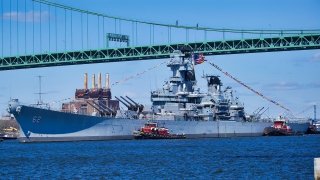USS Kentucky: The Montana-Class Turned Iowa-Class Battleship The Navy Never Finished
The USS Kentucky, BB-66, a vessel initially intended to be a powerhouse of the U.S. Navy's Montana-class, illustrates the evolving priorities and strategic shifts in naval warfare during and after World War II.
Summary: The USS Kentucky, BB-66, a vessel initially intended to be a powerhouse of the U.S. Navy's Montana-class, illustrates the evolving priorities and strategic shifts in naval warfare during and after World War II. Planned as the epitome of U.S. battleship design, the Kentucky's fate was altered by the emerging dominance of aircraft carriers in naval strategy, highlighted by pivotal battles such as Coral Sea and Midway. Reordered as an Iowa-class battleship for expedited production, its construction was ultimately deprioritized in favor of carriers, reflecting a significant shift from battleship to carrier-centric naval power. Despite various proposals to convert the partially constructed Kentucky into an aircraft carrier or an anti-aircraft battleship, these plans were sidelined due to practical considerations of cost, effectiveness, and the rapid advancement of missile technology.
USS Kentucky: The Lost Battleship
As war loomed in the 1930s, the U.S. Navy raced to build up its battleship fleet. The Washington Naval Treaty’s restrictions on ship size and armaments were being set aside as Japan and Italy scrapped the treaty to build larger fleets. In response, the U.S. designed the South Dakota- and Iowa-class battleships. In addition to these two fast battleship types, Navy designers began work on the proposed Montana class, set to be the largest, heaviest, best-armed and most heavily armored battleships ever produced by the U.S. They were set to mount twelve 16-inch guns in four turrets, up from the nine-in-three combinations of all other U.S. battleships. The USS Kentucky, BB-66, was the second proposed Montana-class vessel.
Design and Construction
Although initially planned as a Montana-class ship, in 1940 the Kentucky was reordered as an Iowa-class vessel to speed up production. This would do little to help, however, as the U.S. began to prioritize carrier production. The Battles of Coral Sea and Midway stressed the importance of carriers in the Pacific theater, and as such, Essex-class carriers were moved to the top of the production queue.
At the same time, the Navy realized the importance of fielding fast battleships that could keep pace with carriers and provide an anti-aircraft screen. This led to the full cancellation of the Montana class as the Navy accepted the lighter armor of the Iowas in exchange for their increased speed.
Construction of the Kentucky began in March 1942 but never made it very far. After only three months, the completed bottom structure was launched, as the drydock was needed to construct more landing ships. The vessel remained this way for two years, until work resumed in December 1944.
During this period, Navy planners explored the possibility of converting the Kentucky into an aircraft carrier. In keeping with the prominence of carriers in the Pacific, this plan would have laid an 864-foot flight deck on the ship. This idea fell by the wayside. The final design meant she would have carried fewer aircraft than the Essex carriers, and construction would have been lengthier and more costly to complete than a standard carrier.
The following year, in December 1945, designers considered plans to complete the Kentucky as an anti-aircraft battleship. Work was again stopped in August 1946 to consider this proposal. Another two years passed before work began again at a desultory pace until January 1950, when it was stopped for a final time.
Proposed Conversions and Fate:
Beginning in the mid-1940s and throughout the 1950s, designers experimented with conversions that would have seen the Kentucky completed as a guided-missile battleship. These never came to fruition due to the rapid advance of guided-missile technology. Instead, the Kentucky spent her last decade as a parts depot for various other vessels. Most notably, in 1956, her bow was removed and given to the Wisconsin, which had been damaged in a collision that year.
In 1958, the Kentucky was removed from the Naval Vessel Register and sold for scrap.
About the Author: Maya Carlin
Maya Carlin, National Security Writer with The National Interest, is an analyst with the Center for Security Policy and a former Anna Sobol Levy Fellow at IDC Herzliya in Israel. She has by-lines in many publications, including The National Interest, Jerusalem Post, and Times of Israel. You can follow her on Twitter: @MayaCarlin.
Image is of Iowa-Class Battelship USS New Jersey. Image is Creative Commons.


